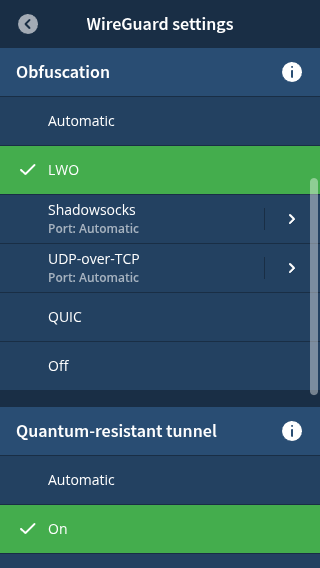Mullvad VPN adds ultra-fast obfuscation to beat WireGuard blocking
Lightweight WireGuard Obfuscation helps you get past firewalls and censorship

- Mullvad VPN has just added Lightweight WireGuard Obfuscation (LWO)
- It promises to defeat VPN blocks, without losing performance
- LWO is currently available on all desktop platforms and Android
Mullvad VPN has just added Lightweight WireGuard Obfuscation (LWO) to its WireGuard protocol connections. Its goal is to help users bypass increasingly sophisticated VPN blocks, such as those found in restrictive networks and national firewalls.
Even if WireGuard is outright blocked on the protocol level, LWO should help bypass that. The new feature isn't just effective, though. It's also much less punishing than other obfuscation methods, allowing for fast connection speeds even on low-powered devices.
This update could make the Mullvad VPN app functional in places that often can't benefit from the protection of some of the best VPN services. Right now, LWO is available for Mullvad users on desktop and Android, with iOS support coming in a future release.
How does Lightweight WireGuard Obfuscation work?
Lightweight WireGuard Obfuscation (LWO) is Mullvad's newest anti-censorship feature. It's built directly on top of the WireGuard protocol.
Instead of wrapping traffic in additional layers, as some other VPN obfuscation methods tend to do, LWO takes a more efficient approach.
"Generally, obfuscation comes with significant processing overhead, which affects throughput. LWO is extremely lightweight to be point of hardly being measurable," a Mullvad representative told TechRadar.
In practice, Mullvad explains, LWO scrambles the WireGuard headers in place to prevent header fingerprinting. This makes LWO a suitable option to use in restricted networks where WireGuard is being blocked on the protocol level.
Even better, perhaps, these extra steps make your connection more resistant to censorship without slowing it down.
We are excited to add Lightweight WireGuard Obfuscation, aimed at helping users bypass firewalls and censorship. This new feature is now available on all desktop platforms and Android.Read more here: https://t.co/tQg13bGRukNovember 12, 2025
The addition of LWO marks the fourth WireGuard obfuscation update for Mullvad. Most recently, Mullvad also introduced QUIC obfuscation, which differs from LWO in a key way.
"QUIC obfuscation wraps the WireGuard tunnel in a QUIC tunnel. This is computationally very expensive and affects throughput," Mullvad told us, suggesting to use QUIC obfuscation only "in restricted networks that limit the majority of traffic types but permit web traffic."
QUIC was initially only available on desktop, but has been expanded to mobile in October, including both Android and iOS apps.
These changes reflect Mullvad's firm commitment to WireGuard. The VPN service is going to sunset OpenVPN encryption by January 2026, making WireGuard its only encryption protocol.
How to enable the new LWO protocol in Mullvad?

Currently, LWO is available for Mullvad users on desktop and on Android devices, but a Mullvad representative told us that it'll be coming to iOS in the first quarter of 2026.
Mullvad explains that you need to have at least version 2025.13 of the desktop app, or 2025.9 of the Android app, to run LWO.
LWO kicks in if your device can't connect otherwise, so the app will automatically try to use LWO after a few failed connection attempts.
If you'd like Mullvad to default to LWO, you can enable it by going to Settings > VPN Settings > WireGuard Settings > Obfuscation > LWO.
Follow TechRadar on Google News and add us as a preferred source to get our expert news, reviews, and opinion in your feeds. Make sure to click the Follow button!

Monica is a tech journalist with over a decade of experience. She writes about the latest developments in computing, which means anything from computer chips made out of paper to cutting-edge desktop processors.
GPUs are her main area of interest, and nothing thrills her quite like that time every couple of years when new graphics cards hit the market.
She built her first PC nearly 20 years ago, and dozens of builds later, she’s always planning out her next build (or helping her friends with theirs). During her career, Monica has written for many tech-centric outlets, including Digital Trends, SlashGear, WePC, and Tom’s Hardware.
You must confirm your public display name before commenting
Please logout and then login again, you will then be prompted to enter your display name.